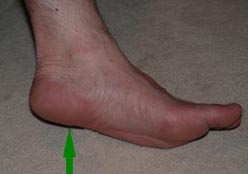What is Plantar Fasciitis?
Plantar fasciitis (often known as policeman’s heel) is a common cause of heel pain, it involves a thickening of the broad band of tissue just below the skin that passes from the heel to the base of the toes.
Why does it develop?
It is suggested from some studies that increased weight, spending a large amount of time on your feet during the day and having tightness of the calf muscles makes you more likely to develop the condition. Heel spurs although often present in this condition, are not thought to be the cause.

Classic site of plantar fasciitis pain.
What symptoms does it cause?
It leads to pain in the sole of the foot near the heel, which peaks first thing in the morning (or on standing having been seated for a while), then eases somewhat and then deteriorates again towards the end of the day.
Can heel pain be caused by anything else?
Yes, there a number of conditions that can cause heel pain and it is important that these are considered by the doctor/ specialist who is treating you.
What options are there for treatment?
a. Stretching
Stretching exercises of the calf muscles and also the plantar fascia itself are the mainstay of treatment of plantar fasciitis. These need to be performed regularly. (See: Plantar Fascia Stretching Exercises).
b. Night splints
These hold the ankle at 90degrees. They have been shown to be effective in some people, but not everyone can tolerate them. There are a number of different types you can discuss this with your doctor/ specialist.
c. Orthotics/ insoles
Formal, custom-made insoles from a podiatrist are occasionally required if you have an abnormal foot posture, however in the majority of patients simple over the counter insoles have been found to be as effective. Simple gel heel cushions may be all that is required- again this can be discussed with your specialist.
d. Surgery
A small operation may be required to lengthen part of your calf muscle if it remains tight despite stretching exercises.
(Another operation, which is very occasionally required, involves cutting part of the plantar fascia to ease your symptoms if no other treatment works).
e. Extracorporeal shock wave lithotripsy
This is a new treatment that is showing encouraging results. It is a simple outpatient procedure that has minimal risks which involves placing a probe on your heel for about 5 minutes, this is performed once a week in outpatients for 3-5 weeks. (See: Extra Corporeal Shock Wave Lithotripsy).
f. Injections
There is evidence to suggest these may be beneficial, but the effect may not be long lasting and they may lead to complications eg. rupture of the plantar fascia, damage to nearby nerves (both of which can be difficult to treat). I recommend that if these are performed, they are done under image guidance/ ultrasound.
What happens if I do nothing?
It has been found that about 80% of people are better after 10 months with no treatment, however therefore about 20% are not. The treatments listed aim to resolve the pain quicker in the 80% who would have got better anyway and resolve the pain in the 20% who would not. It is important to remember that not all of these treatments work in everyone.
